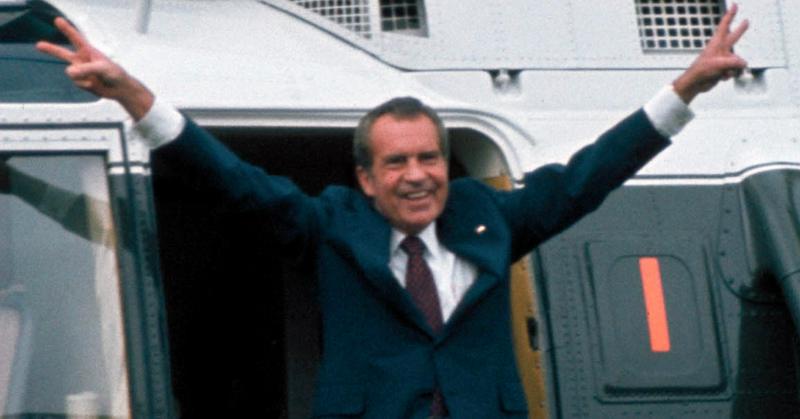Nixon's End: How The Watergate Scandal Brought Down A President
By | November 29, 2016

Following revelations of the Watergate scandal, Richard Nixon announced on August 8, 1974, that he was resigning as President. The next day, following the transfer of office to Vice-President Gerald Ford, Nixon boarded a helicopter and left the White House for good, pausing to flash his trademark "V for victory" sign before he went.
How did this all start?
A Mysterious Break-in At The Watergate Building

Nixon was seeking reelection during a tough time. The optimism of the '60s had given way to a pessimistic mood in the early '70s, as the Vietnam War had continued to divide the nation. Nixon was a brilliant politician, a proven survivor over his long career -- but he was also paranoid. The presidential campaign for Nixon decided to go with a more aggressive and hands-on approach that would ultimately lead to the President's downfall.
In June of 1972, burglars were arrested inside the Democratic National Committee office in the Watergate building in Washington, D.C. It seemed at first like a random break-in -- but why would burglars choose to break into the Watergate building and specifically the DNC office? What was there to steal, other than, perhaps, something to do with the impending election?
The burglars weren’t your average criminals, and they weren't really even burglars -- in fact, they'd been hired by Nixon’s reelection committee. A month before, they had broken in to wiretap phones and steal top-secret documents, an act of illegal espionage. It turned out that the wiretaps were not properly placed, so the crew of had to break in again re-tap the phones. This time around they were caught red-handed. Though it was a very suspicious incident, there was no evidence, initially, that Nixon knew about or condoned the break-in.
The Investigation Leads To The President

More and more, though, journalists began finding clues that the break-in might have had a connection to the White House. One of the burglars was associated with the CIA, and another was found with the phone number of a former White House employee who was known to be part of the "Plumbers," a White House special investigation unit.
Nixon continued to deny any connection, swearing that his staff were not involved. The Presidential election proceeded as scheduled and Nixon was reelected as the President of the United States -- in a landslide.
In truth, a cover-up was underway. Lies were told and documents were destroyed by people in the campaign as well as the FBI.
With evidence mounting that something was not quite right in the White House, the U.S Senate opened an official investigation. They learned that the FBI was indeed involved with the cover-up, leaving people wondering whether other top White House aides were connected as well. When one of the "burglars" threatened to reveal what truly happened, Nixon chose to pay him hush money. To trick the public and those who were onto him, Nixon started his own investigation, which would of course find nothing damning while muddying the waters for the real investigation.
Nixon’s efforts to cover up and trick the public failed. He was eventually subpoenaed by the Supreme Court for the documents and 64 tapes of his own conversations. The tapes revealed the extent of the cover-up, and that Nixon had known about (and possibly ordered) the initial break-ins.
It was the end for President Nixon. Congress voted to begin impeachment proceedings, but Nixon wanted to go out his own way, and decided to resign on August 8. President Gerald Ford ended up pardoning Nixon for his alleged crimes, reasoning that Nixon had already been sufficiently disgraced and the best thing for the country was to move on.
